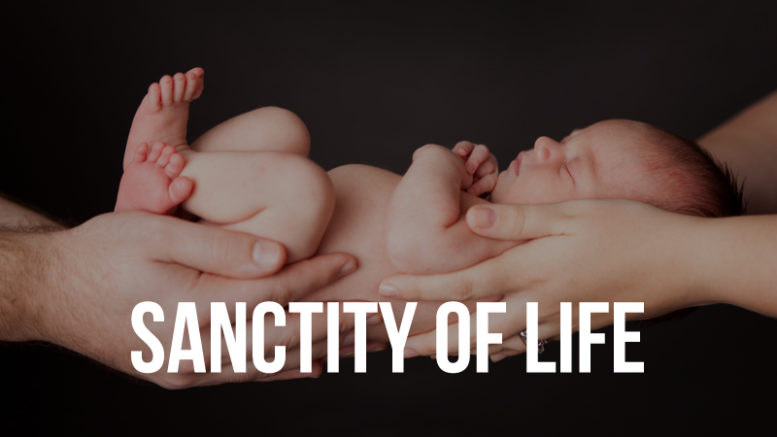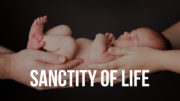Playback speed:
One of the foundational 7 key issues the Virginia Christian Alliance promotes is the sanctity of human life and the right to life for a child in its mother’s womb.
VCA’s core issue of the sanctity of human life we will discuss the latest ethical issues in greater detail, providing definitions, examples, and facts about their methodologies. It is our hope that God might reveal His deep love and respect for all forms of human life.
In today’s humanistic culture, individuals are tinkering with ethical boundaries in science, namely genetics, pushing research and experimentation to the limit. In 1973, the monumental court case, Roe v. Wade, altered the bioethical playing field in the United States forever. For the first time in history, a mother could kill her unborn child without any legal consequences, violating the sanctity of human life.
Years later, a sheep named Dolly was cloned in a Scottish laboratory, and scientists around the world claimed they could clone human beings next. Likewise, stem cell research is one of the pivotal debates of the twenty-first century. In-vitro fertilization poses severe ethical concerns because it often leads to the destruction of excess embryos. Infanticide, euthanasia, and suicide, while not necessarily “scientific,” are issues also facing our modern “culture of death.”
We hope to promote the sanctity of human life and the right to life for a child in its mother’s womb. This argument is steeped in Biblical scripture, given to us by God as a testament to His vision for our lives. Later, we will discuss the latest ethical issues in greater detail, providing definitions, examples, and facts about their methodologies. It is our hope that God might reveal His deep love and respect for all forms of human life.
What the Bible Says About the Sanctity of Human Life
Life is one of the most abundant themes of the Bible. Dozens of verses refer to God providing life, creating life, defending life, delighting in life, and restoring life. The Bible declares that God is the giver (Acts 17:25) and author of life (Acts 3:15).
Furthermore, Jesus states, “The thief comes only to steal and kill and destroy; I have come that they may have life, and have it to the full” (John 10:10). God created all life on earth. He literally breathed life into Adam (Genesis 2:7). Moreover, He fashioned Adam and Eve in His likeness. Genesis 1:27 states, “So God created man in his own image, in the image of God he created him; male and female he created them.” Because “every human being is created by God and in His image, every [one] has intrinsic rather than relative value.”[1]
God Made Them, Life is Sacred
In Answering the Call, John Ensor writes, “[Humans] are not to be destroyed when “unwanted.” God made them. God wants them and he cherishes them! They are not to be discarded, sacrificed, or euthanized because they are useless to others.”[2] God appreciates all human life. He sees us from a perspective we can hardly even begin to fathom.
Life is sacred to God, and as Christians, we have been given a charge to protect it and uphold the sanctity of life in the public square:
“Speak up for those who cannot speak for themselves, for the rights of all who are destitute” (Proverbs 31:8-9).
God especially cherishes innocent human life (Exodus 23:7).
The Bible specifically refers to the baby in the Book of Psalm: “You created my inmost being: you knit me together in my mother’s womb. I praise you because I am fearfully and wonderfully made” (Psalm 139:13-14). Ensor describes the womb as God’s “personal art studio,”[3] where He personally designs every human being. Lastly, God has a plan for every human life, even before conception (Jeremiah 29:11).
Abortion
In 1973, the U.S. Supreme Court decided the preborn child did not count as a person. Therefore, it could be “aborted for any reason or no reason.”[4] Since then, “Americans have intentionally destroyed more than 40 million human beings in utero.”[5] Imagine all the people God created who have been cheated out of their lives.
Aside from what the Bible says about the sacredness of life, one of the oldest Christian documents, the Didache, is quite clear on the issue, as well: “There are two different ways: the way of life and the way of death, and the difference between these two ways is great.
Therefore, do not murder a child by abortion or kill a newborn infant.”[6] Even more specific is a segment in the Apologeticus, stating:
For us murder is once for all forbidden; so even the child in the womb, while yet the mother’s blood is still being drawn on to form the human being, it is not lawful for us to destroy. To forbid birth is only quicker murder. It makes no difference whether one take away the life once born or destroy it as it comes to birth. He is a man, who is to be a man; the fruit is always present in the seed.[7]
An Embryo is an Individual with Rights
One of the biggest obstacles is that many individuals have a difficult time seeing a human embryo as an actual person. They don’t recognize the sanctity of human life in one. But, if one looks at the genetic makeup of a human being, though, it becomes easier. Every human has forty-six chromosomes. A female egg has twenty-three of those chromosomes, while a male sperm has the other twenty-three. When the two come together, an embryo is formed with the same forty-six chromosomes he or she will have their entire life.
They now have the genetic makeup of a human being.[8] Also, scientists have recently discovered that babies feel pain during abortion. According to Dr. Kanwaljeet Anand, a pediatrician at the University of Arkansas, “unborn children suffer “severe and excruciating” pain because “the [baby] is conscious” during the abortion procedure.”[9] Furthermore, Dr. Anand said, “The baby shows increased heart rate, blood flow and hormone levels responding to pain during the abortion.”[10]
Brutal Abortion Techniques
There are currently several abortion techniques in use. Suction Aspiration is one. In this procedure, the abortionist tears the baby into pieces and sucks the pieces it into a knife-like hollow tube. [11] In Dilatation & Curettage, the abortionist “inserts a curette, a loop-shaped steel knife, up into the uterus,” and cuts the baby into pieces, causing much bleeding.[12] A method recently developed, called “Partial Birth Abortion” or “Brain Suction” seems the most inhumane. Eighty percent of the babies aborted by this technique are healthy, viable children.[13] In this procedure, the abortionist partially delivers the baby. Then, scissors are “jammed into the base of the skull.” Next, “a tube is inserted into the skull, and the brain is sucked out.” The baby’s skull is collapsed, and the abortionist now pulls out the dead infant.[14]
Infanticide violates the Sanctity of Human Life
Another serious ethical issue the world today must face is the slaughtering of innocent children. “Infanticide is the killing of a born child – whether that killing is accomplished by a direct act on the part of someone, or whether ordinary care, vital to the child’s survival, such as feeding, is refused.”[15] In most cases, a child may be allowed to die because he or she is born deformed, perhaps handicapped or mentally retarded. The parents might choose to have their child starved to death so that he or she will never have to live a life of ongoing struggle. But what some parents might consider merciful God considers murder. Who is to decide that a life is not worth living but God, the creator of life? God has a plan for every one, and “disability and unhappiness do not necessarily go together.”[16]
Cloning & Embryonic Stem Cell Research
Much like abortion, cloning and stem cell research are also at the forefront of modern science. In February of 1997, scientists in Edinburgh, Scotland, successfully cloned the first adult mammal, a sheep named Dolly.[17] This major breakthrough in genetic manipulation shocked the world; as a result, President Clinton assigned the National Bioethics Advisory Commission (NBAC) to investigate the potentials and dangers of human cloning.[18]
On June 9, 1997, the NBAC revealed its findings, coming to the conclusion: “At this time it is morally unacceptable for anyone in the public or private sector, whether in research or clinical setting, to attempt to create a child.”[19] While President Clinton halted federal funds for any such research for the next five years, plenty of private businesses soon expressed their interests in developing the first human clone.[20]
The Right to Life is from God’s Design and Through Sexual Reproduction
The President’s Council on Bioethics defines cloning as “a form of reproduction in which offspring result not from the chance union of egg and sperm (sexual reproduction) but from the deliberate replication of the genetic makeup of another single individual (asexual reproduction).”[21] From a Christian perspective, it is easy to see the problem with human cloning. The process takes sexual intercourse completely out of the equation. But God intended man and woman to unite as one flesh through sexual reproduction. By creating a human child through asexual means is a slap in the face to God, much like it is when we kill an innocent human baby.
Human Cloning is Destructive
Human cloning is also unsafe and destructive in nature. The President’s Council asserts that “given the high rates of morbidity and mortality in the cloning of other mammals, we believe that cloning-to-produce-children would be extremely unsafe [and] unethical.”[22] In other words, many human embryos would be destroyed in the experimentation process.
Many advocates of cloning and stem cell research discuss the potential good genetic research has in store. For example, stem cell research might lead to the curing of many diseases, such as Alzheimer’s and Parkinson’s disease. In short, stem cell research could potentially heal those who are suffering. However, we must be wary of the Humanist mindset that emphasizes the self. It is selfish.
Suffering is a way of life and appears part of God’s plan for our lives. As soon as we begin to clone human beings or manipulate and discard human embryos through stem cell research, we will begin to view the “seeds of the next generation as mere raw material for satisfying the needs of our own.”[23] This is an afront to the sanctity of human life.
President’s Council claims:
Doing so would coarsen our moral sensibilities and make us a different society: one less humble toward that which we cannot fully understand, less willing to extend the boundaries of human respect ever outward, and more willing to transgress moral boundaries once it appears to be in our own interest to do so.[24]
In addition, “all extractions of stem cells from human embryos, cloned or not, involve the destruction of these embryos.”[25] This is just as bad as abortion. While some supporters of stem cell research have discussed the possibility of only using embryos slated for destruction, it is not our right to sacrifice innocent human lives so that others will live.
The Complications of In-Vitro Fertilization
In-vitro fertilization (IVF) is a means by which unfertile couples can potentially have a child from their own genetic lineages. In the procedure, a woman is given drugs to induce ovulation, so that eggs can be harvested, which will then be mixed in a dish with a male’s semen. Fertilization often occurs, and multiple embryos (typically 3 to 5) are implanted in the woman’s uterus. Some of these embryos will surely die. In addition, many scientists practice “pick of the litter” selection by only choosing certain embryos.
The remaining embryos are discarded (destroyed).[26] Emedicinehealth.com states that the IVF procedure was first done successfully in the United States in 1981, but since then, 250,000 babies have been born through this technique. It is also unsafe; many children born by IVF end up with severe handicaps and other deformities. Many children do not live through the delivery.[27]
Euthanasia and Suicide
Euthanasia, suicide, and doctor-assisted suicide, while not necessarily scientific, are still major concerns that face today’s society. With the amount of suffering in the world, there are many individuals lying in hospital beds with terminal illnesses. In some cases, there seems no hope for recovery. Euthanasia and suicide are the result. “Tthe intentional killing by act or omission of a dependent human being for his or her alleged benefit.” is the definition of euthanasia. [28]
Euthanasia is only legal in Belgium and the Netherlands. While it is not legal in the United States, assisted suicide is legal in the state of Oregon.[29] Regardless, euthanasia is still practiced in the United States in secrecy and is a crime.
Alternatives to thes Forms of Suicide
One of the most frequently asked questions about euthanasia is whether people should be forced to stay alive, especially when their quality of life has diminished. The answer to this question is no, but euthanasia and any form of suicide is still unacceptable. There is an alternative, because “the law already permits patients or their surrogates to withhold or withdraw unwanted medical treatment even if that increases the likelihood that the patient will die.”[30]
Ultimately, euthanasia and suicide pose the same question as abortion and genetic research: has God given us the right to choose who lives and dies? He has not, and by assisting in one’s suicide we take their fate into our own hands. Suicide is an afront to God, because He created us. In the end, it is His decision when and how His children should die, and we must respect His judgment.
Conclusion
As the twenty-first century unfolds, technological breakthroughs in genetics will continue to occur. The rise of technology has already broken free of its leash and is running rampant throughout the world. Certainly, not all technology is bad, but genetic technologies – as in abortion, stem cell research, and in-vitro fertilization – pose a direct threat to our integrity and God’s will for our lives.
Fight for Life
We must fight for the sanctity of human life, whether someone is dying slowly in a hospitable bed or only beginning his or her journey in a mother’s womb.
[1]John Ensor, Answering the Call: Saving Innocent Lives, One Woman at a Time (Colorado Springs: Focus on the Family, 2003), 39.
[2]Ibid., 40.
[3]Ibid., 43.
[4]Ibid., 104.
[5]Ibid., 17.
[6]Clayton Jefford, ed., The Didache in Context, Essays on Its Test, History and Transmission (Leiden, The Netherlands: E.J. Brill, 1995), 1.1; 2.2.
[7] C. Everett Koop and Francis A. Schaeffer, Whatever Happened to the Human Race? (Westchester: Crossway Books, 1983), 51.
[8]Ibid., 16.
[9]Steven Ertelt. “Dr: Unborn Children Feel Pain During Partial-Birth Abortion.” Science Ministries. http://www.scienceministries.org(accessed June 28, 2007).
[10]Ibid.
[11]Dr. J.C. Willke. “Why Can’t We Love Them Both.” Abortion Facts. http://www.abortionfacts.com/online_books/love_them_both/why_cant_we_love_them_both_18.asp (accessed June 29, 2007).
[12]Ibid.
[13]Ibid.
[14]Ibid.
[15]Koop and Schaeffer, Whatever Happened to the Human Race?, 29.
[16]Ibid., 30.
[17]David Goodnough, The Debate Over Human Cloning (Berkeley Heights: Enslow Publishers, 2003), 8.
[18]Ibid, 12.
[19]Ibid, 13.
[20]Ibid.
[21]The President’s Council on Bioethics, Human Cloning and Human Dignity (New York: Public Affairs, 2002), XLIII.
[22]Ibid, XLVIII.
[23]Ibid, LIV.
[24]Ibid, LV.
[25]Ibid, XLVI.
[26]Dr. J.C. Willke. “Why Can’t We Love Them Both.” (Accessed June 29, 2007).
[27]Ibid.
[28]Rita L. Marker and Kathi Hamlon. “Euthanasia and Assisted Suicide: Frequently Asked Questions.” The International Taskforce on Euthanasia and Assisted Suicide. http://www.internationaltaskforce.org/faq.htm (Accessed June 29, 20).
[29]Ibid.
[30]Ibid.





